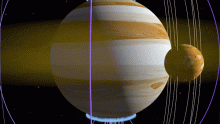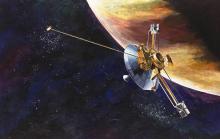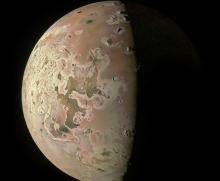Listen to today's episode of StarDate on the web the same day it airs in high-quality streaming audio without any extra ads or announcements. Choose a $8 one-month pass, or listen every day for a year for just $30.
You are here
Moon and Companions
The Moon swings past a couple of bright companions the next few nights — the planet Jupiter and the star Spica. Jupiter is the solar system’s largest planet, and looks like a brilliant star to the lower left of the Moon as darkness falls tonight. Fainter Spica, the leading light of Virgo, stands below Jupiter.
The gap between Jupiter and Spica will stay about the same for another couple of months. As we get deep into summer, though, Jupiter will start moving toward Spica. And by the start of autumn, it’ll have passed the bright star, and will be leaving it behind at a pretty good clip.
That changing gap is the result of Jupiter’s orbit around the Sun, and our changing viewing angle on the planet.
It takes Jupiter about 12 years to complete one full turn against the background of stars, so it moves slowly across the sky. That means it can linger near a particular star for a good while.
But Jupiter’s position as seen from Earth also depends on Earth’s orbit. We follow a smaller, faster path around the Sun, so we pass by Jupiter once every 13 months or so. In fact, we just passed it last month.
As we pass Jupiter, it appears to stop its normal eastward motion across the sky, and actually move backwards for a while. When Earth gets far enough ahead, though, Jupiter once again resumes its eastward crawl. So the changing gap between Jupiter and Spica is the result of the orbital motions of two planets.
More about Jupiter and the Moon tomorrow.
Script by Damond Benningfield






